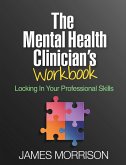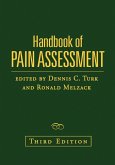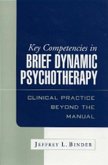- Gebundenes Buch
- Merkliste
- Auf die Merkliste
- Bewerten Bewerten
- Teilen
- Produkt teilen
- Produkterinnerung
- Produkterinnerung
The third edition of this incisive practitioner resource and course text--updated for the DSM-5 Text Revision (DSM-5-TR)--takes the reader step by step through diagnostic decision making in mental health.
Andere Kunden interessierten sich auch für
![Relational Theory and the Practice of Psychotherapy Relational Theory and the Practice of Psychotherapy]() Paul L WachtelRelational Theory and the Practice of Psychotherapy63,99 €
Paul L WachtelRelational Theory and the Practice of Psychotherapy63,99 €![The Mental Health Clinician's Workbook The Mental Health Clinician's Workbook]() James MorrisonThe Mental Health Clinician's Workbook66,99 €
James MorrisonThe Mental Health Clinician's Workbook66,99 €![Handbook of Pain Assessment Handbook of Pain Assessment]() Handbook of Pain Assessment96,99 €
Handbook of Pain Assessment96,99 €![Therapy in the Real World Therapy in the Real World]() Nancy Boyd-FranklinTherapy in the Real World74,99 €
Nancy Boyd-FranklinTherapy in the Real World74,99 €![Casebook of Evidence-Based Therapy for Eating Disorders Casebook of Evidence-Based Therapy for Eating Disorders]() Casebook of Evidence-Based Therapy for Eating Disorders60,99 €
Casebook of Evidence-Based Therapy for Eating Disorders60,99 €![Key Competencies in Brief Dynamic Psychotherapy Key Competencies in Brief Dynamic Psychotherapy]() Jeffrey L BinderKey Competencies in Brief Dynamic Psychotherapy76,99 €
Jeffrey L BinderKey Competencies in Brief Dynamic Psychotherapy76,99 €![Dialectical Behavior Therapy for Binge Eating and Bulimia Dialectical Behavior Therapy for Binge Eating and Bulimia]() Debra L SaferDialectical Behavior Therapy for Binge Eating and Bulimia48,99 €
Debra L SaferDialectical Behavior Therapy for Binge Eating and Bulimia48,99 €-
-
-
The third edition of this incisive practitioner resource and course text--updated for the DSM-5 Text Revision (DSM-5-TR)--takes the reader step by step through diagnostic decision making in mental health.
Produktdetails
- Produktdetails
- Verlag: Guilford Publications
- 3rd edition
- Seitenzahl: 348
- Erscheinungstermin: 15. Januar 2024
- Englisch
- Abmessung: 231mm x 152mm x 28mm
- Gewicht: 640g
- ISBN-13: 9781462553419
- ISBN-10: 1462553419
- Artikelnr.: 68395242
- Herstellerkennzeichnung
- Libri GmbH
- Europaallee 1
- 36244 Bad Hersfeld
- gpsr@libri.de
- Verlag: Guilford Publications
- 3rd edition
- Seitenzahl: 348
- Erscheinungstermin: 15. Januar 2024
- Englisch
- Abmessung: 231mm x 152mm x 28mm
- Gewicht: 640g
- ISBN-13: 9781462553419
- ISBN-10: 1462553419
- Artikelnr.: 68395242
- Herstellerkennzeichnung
- Libri GmbH
- Europaallee 1
- 36244 Bad Hersfeld
- gpsr@libri.de
James Morrison, MD, is Affiliate Professor of Psychiatry at Oregon Health and Science University in Portland. His long career includes extensive experience in both the private and public sectors. With his acclaimed practical books--including DSM-5-TR Made Easy; Diagnosis Made Easier, Third Edition; The First Interview, Fourth Edition; and others--Dr. Morrison has guided hundreds of thousands of mental health professionals and students through the complexities of clinical evaluation and diagnosis.
Introduction
I. The Basics of Diagnosis
1. The Road to Diagnosis
2. Getting Started with the Roadmap
3. The Diagnostic Method
4. Putting It Together
5. Coping with Uncertainty
6. Multiple Diagnoses
7. Checking Up
II. The Building Blocks of Diagnosis
8. Understanding the Whole Patient
9. Physical Illness and Mental Diagnosis
10. Diagnosis and the Mental Status Examination
III. Applying the Diagnostic Techniques
11. Diagnosing Depression and Mania
12. Diagnosing Anxiety, Fear, Obsessions, and Worry
13. Diagnosing Psychosis
14. Diagnosing Problems of Memory and Thinking
15. Diagnosing Substance Use and Other Addictions
16. Diagnosing Eating and Sleeping Disorders
17. Diagnosing Personality and Relationship Problems
18. Beyond Diagnosis: Compliance, Suicide, Violence
19. Patients, Patients
Appendix: Diagnostic Principles
References and Suggested Readings
Index
I. The Basics of Diagnosis
1. The Road to Diagnosis
2. Getting Started with the Roadmap
3. The Diagnostic Method
4. Putting It Together
5. Coping with Uncertainty
6. Multiple Diagnoses
7. Checking Up
II. The Building Blocks of Diagnosis
8. Understanding the Whole Patient
9. Physical Illness and Mental Diagnosis
10. Diagnosis and the Mental Status Examination
III. Applying the Diagnostic Techniques
11. Diagnosing Depression and Mania
12. Diagnosing Anxiety, Fear, Obsessions, and Worry
13. Diagnosing Psychosis
14. Diagnosing Problems of Memory and Thinking
15. Diagnosing Substance Use and Other Addictions
16. Diagnosing Eating and Sleeping Disorders
17. Diagnosing Personality and Relationship Problems
18. Beyond Diagnosis: Compliance, Suicide, Violence
19. Patients, Patients
Appendix: Diagnostic Principles
References and Suggested Readings
Index
Introduction
I. The Basics of Diagnosis
1. The Road to Diagnosis
2. Getting Started with the Roadmap
3. The Diagnostic Method
4. Putting It Together
5. Coping with Uncertainty
6. Multiple Diagnoses
7. Checking Up
II. The Building Blocks of Diagnosis
8. Understanding the Whole Patient
9. Physical Illness and Mental Diagnosis
10. Diagnosis and the Mental Status Examination
III. Applying the Diagnostic Techniques
11. Diagnosing Depression and Mania
12. Diagnosing Anxiety, Fear, Obsessions, and Worry
13. Diagnosing Psychosis
14. Diagnosing Problems of Memory and Thinking
15. Diagnosing Substance Use and Other Addictions
16. Diagnosing Eating and Sleeping Disorders
17. Diagnosing Personality and Relationship Problems
18. Beyond Diagnosis: Compliance, Suicide, Violence
19. Patients, Patients
Appendix: Diagnostic Principles
References and Suggested Readings
Index
I. The Basics of Diagnosis
1. The Road to Diagnosis
2. Getting Started with the Roadmap
3. The Diagnostic Method
4. Putting It Together
5. Coping with Uncertainty
6. Multiple Diagnoses
7. Checking Up
II. The Building Blocks of Diagnosis
8. Understanding the Whole Patient
9. Physical Illness and Mental Diagnosis
10. Diagnosis and the Mental Status Examination
III. Applying the Diagnostic Techniques
11. Diagnosing Depression and Mania
12. Diagnosing Anxiety, Fear, Obsessions, and Worry
13. Diagnosing Psychosis
14. Diagnosing Problems of Memory and Thinking
15. Diagnosing Substance Use and Other Addictions
16. Diagnosing Eating and Sleeping Disorders
17. Diagnosing Personality and Relationship Problems
18. Beyond Diagnosis: Compliance, Suicide, Violence
19. Patients, Patients
Appendix: Diagnostic Principles
References and Suggested Readings
Index








